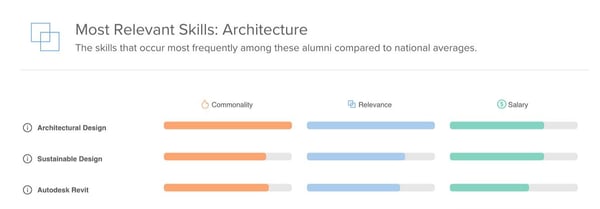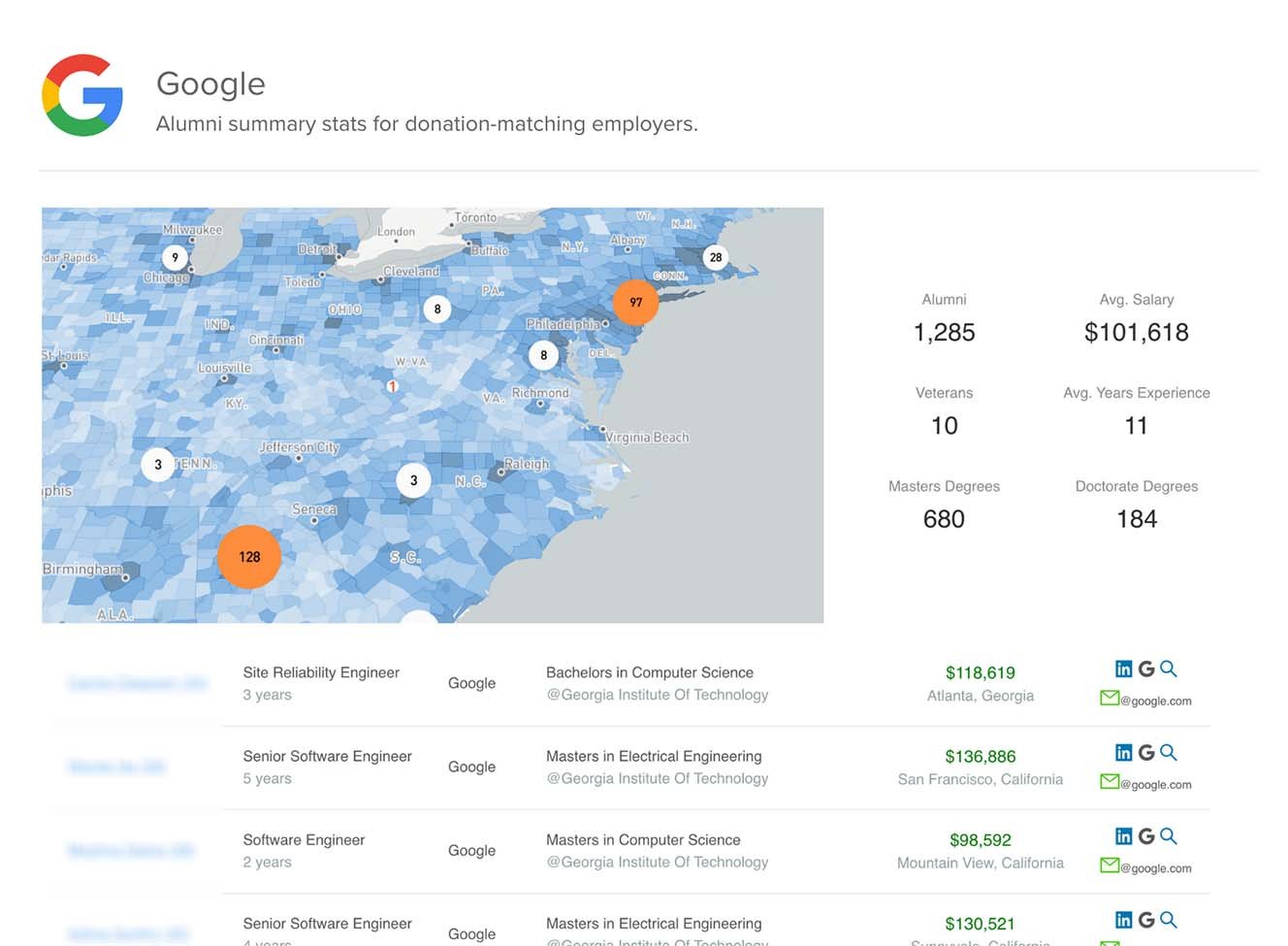Like all industries, higher education is feeling the pressure to become data-driven — and there's a reason for it. Leading with data means making decisions based on evidence, not intuition. It means supporting actionable solutions with intelligence and transparency. And perhaps above all else, a data-driven institution can prove and improve the value of a degree.
When it comes to data intervention, university faculty and staff may feel overwhelmed without a strategy. How can your teams possibly manage another resource when you barely have time to learn the systems in place?
Let us break it down for you.
Graduate outcomes data is arguably one of the most diverse resources a college or university can tap into. It's not a one-size-fits-all strategy, so every department has the opportunity to shape the objective to fit their needs, or analyze the data through their own unique lens.
Wondering what this looks like for your university? Here are seven ways to put graduate outcomes data to work for you.
1. Analyze the skills gap at your institution with graduate outcomes data
Where could your institution improve? Roughly 83% of employers in a recent survey said they're having a tough time finding candidates with the skills necessary to hire. Overall, the difference between job openings and actual hires is about 1.5 million, and has been for several years. This clearly indicates a gap in learning and training.
To address the skills gap at your institution, we'll define two methods using graduate outcomes data. The first is a supply and demand analysis of the skills your programs produce versus the skills employers hire for.
In the example below, you'll notice this university produces a volume of graduates with software development skills that exceed the volume at Google. In other words, Google will source candidates from this available talent pool. You'll also notice the shortage of graduates who report the C++ programming language skill. Google may look elsewhere for these hires.
Armed with this information, institutional research analysts can communicate to academic planning teams the need to adjust computer science curriculum for the benefit of both students and employers.
 The second method is a program-specific skills analysis to identify the most common, most relevant and highest paying skills your alumni report by college or degree. Create a student-focused approach by prioritizing the real-world skills employers demand, and promote accountability for every program with advanced evaluations of curriculum by degree.
The second method is a program-specific skills analysis to identify the most common, most relevant and highest paying skills your alumni report by college or degree. Create a student-focused approach by prioritizing the real-world skills employers demand, and promote accountability for every program with advanced evaluations of curriculum by degree.

2. Create a curriculum that meets market demand
If colleges and universities don't re-evaluate their curriculum at regular intervals, programs will inevitably stale. A widely quoted statistic by Dell Technologies reports that 85% of jobs in 2030 haven't been invented yet. In Dell's research, the distance between student assets and employer expectations will continue to grow, unless something is done today.
A skills gap analysis powered by graduate outcomes data is a good place to start. Understand where your deficits are in order to design a curriculum that can meet the demands of a shifting employment market. By eliminating data silos with advanced workforce analytics, your teams can proactively uncover trends to inform leadership early and often.
Improve the value of a degree from your institution with in-demand and relevant education. Boost enrollment, enhance relationships with employers and generate a positive ROI.
3. Close gaps in first-destination and alumni survey data with graduate outcomes
First-Destination Surveys (FDS) have become the standard for capturing outcomes of new graduates within the first six months of graduation. The National Association of Colleges and Employers (NACE) advocates all universities subscribe to this method.
These surveys are designed to understand more about the employment and continuing education goals and activities of college graduates, providing important information to help inform prospective students and their families as well as the general public about post-graduation outcomes.
-The National Association of Colleges and Employers (NACE)
Some universities see great success with surveys. Princeton reports a 98% response rate by requiring students to complete their FDS before getting their cap and gown. For schools with a low response rate, graduate outcomes data can fill the gaps to tell a richer story of success by cohort, class and college.
Stakeholders, students and employers want to understand the lifetime value of an education from your institution before they invest time and money. Graduate outcomes data picks up where post-graduation surveys leave off to communicate the impact of a degree 2, 10 and even 20 years after graduation.
4. Support fundraising goals with rich workforce analytics and advanced alumni outcomes data
Supercharge your fundraising efforts with graduate outcomes data to build sustainable, meaningful support. The secret is segmentation. Structure every campaign around a targeted alumni group based around your goals:
1. Reach high-earning alumni by industry for income-based campaigns.
2. Identify alumni who work for donation-matching employers.
3. Understand alumni migration trends for better event targeting and turnout.

5. Give students access to real, relevant career pathways by program
The future of work depends on the decisions students make today. First, encourage awareness and flexibility with data-driven stories of real people in the workforce. Then, share both linear and nonlinear pathways to bring attention to the skills that translate across a variety of disciplines. Finally, teach students to communicate these skills to potential employers.
Georgia State University teaches students to transition seamlessly from college to career through their latest QEP, which helps students connect, track and document their path to a career. Every GSU major has a career page powered by graduate outcomes data to drive informed decisions. English majors, for instance, will learn they can get hired in the healthcare industry as a marketing professional earning $66K a year. GSU also gives every student access to the Steppingblocks digital career counselor with over 100 million real career pathways to explore and develop.

6. Understand employer hiring trends to boost relationships and meet market needs
Are you engaging with the right employers? Align your efforts with theirs by supplying a workforce that meets demand.
Analyze your graduate outcomes data to understand your top employers, the skills they hire for, the schools they hire from and how you can improve your course offerings over time.
If you can create a dialogue with evidence showcasing alumni success, top employers will hire more of your students, you'll improve the value of a degree from your institution and long-term, sustainable partnerships will be easier to come by.
7. Invite important alumni to career fairs and mentoring events
Reconnect with successful alumni working in relevant fields or industries to share how their education investment has paid-off. Give students a mentor who looks like them using alumni outcomes data to reveal demographic, geographic, gender, salary and degree program attributes.
For example, if you're hosting an event around women in tech, segment your alumni by females working in IT who graduated with a computer science degree and earn over $100K a year. You can even segment by age to celebrate the top women in tech under 40. Bring relevancy to your career fairs, mentorships and events by bridging gaps from college to career.
How graduate outcomes work in real life
Wondering how organizations like yours actually use this type of data?
Georgia State University: GSU uses graduate outcomes data to share real career paths with students by degree or field of study at both the national and institutional level to improve retention, graduation and participation across the university.
The Institute for Research on Innovation and Science: IRIS and Steppingblocks have partnered to measure the impact of over $100 billion in award spending, providing graduate outcomes data on employees who leave universities after work on sponsored research.
The University of Nevada, Las Vegas: UNLV used graduate outcomes data to segment alumni in a specific geography to drive engagement and attendance for the opening ceremony of a new university building.
Want to see graduate outcomes data for your institution? Contact us today for a free report.

%20(1).png)





